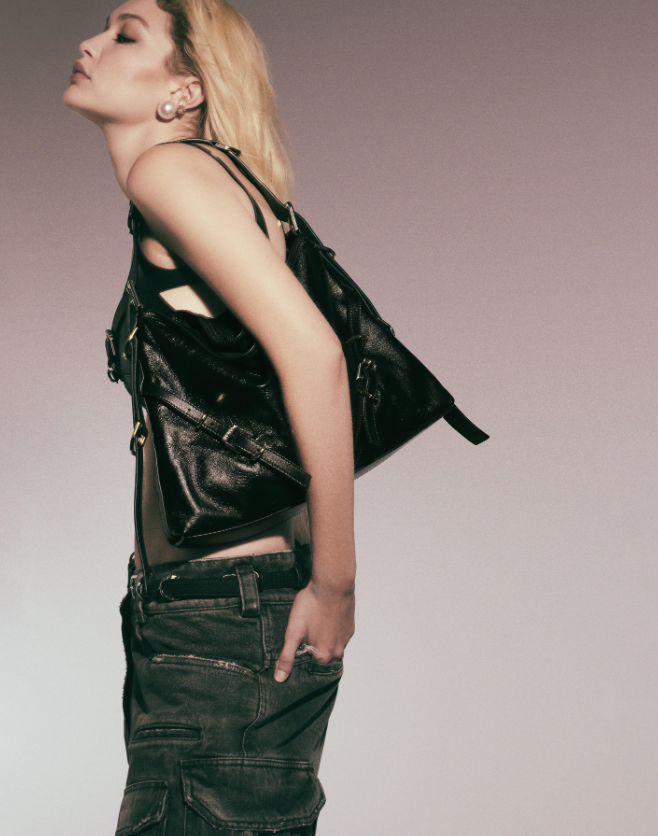Givenchy, who has been chasing trends, finally realized that change is faster than planned.
According to Fashion Business News, Matthew M. Williams, Creative Director of Givenchy, a luxury brand under LVMH, has announced his resignation and will focus on the development of his personal brand 1017 Alyx 9SM in the future.
Matthew M. Williams took over from Clare Waight Keller in June 2020 and became Givenchy’s seventh creative director, responsible for all creative work in the men’s and women’s clothing collections.
In LVMH’s plan, Matthew M. Williams needs to gather a new generation of young consumers through products that integrate high-end fashion and trendy culture, and bring immediate sales boost to the “cash cow” category such as handbags and footwear accessories.
However, in the past three years, his expertise in street aesthetics and functional trends has not led to the emergence of elephant level bestsellers for Givenchy.
The vague market positioning has caused Givenchy to be neglected in the market. In recent consecutive quarterly performance reports, LVMH specifically mentioned the strong performance of Celine, Loewe, and Marc Jacobs, while Givenchy was not mentioned.
At the same time, the 1017 Alyx 9SM, founded by Matthew M. Williams, finally had a turning point and was acquired by Hong Kong billionaire Zheng Zhigang last month. With the support of Zheng Zhigang, the brand will accelerate its development through measures such as opening boutiques, expanding its product range, and strengthening its team.
Analysts believe that leaving Givenchy after finding a home for the 1017 Alyx 9SM would be an ideal choice for both parties.
Although Matthew M. Williams’s performance at Givenchy was not satisfactory, he almost put aside the then popular 1017 Alyx 9SM for Givenchy’s work, and actively cooperated with the group’s wishes to improve the creative direction, which has demonstrated the sincere dedication of this creative director.
At the same time, unlike the stereotypical image of a cold and powerful luxury brand CEO, industry evaluations of Givenchy CEO Renaud de Lesquin tend to give creative directors ample room to showcase their abilities. This is also why he was able to remain patient with Matthew M. Williams even though he was not well received in the first few series.
It can be believed that the cooperation between the two parties, as stated in the statement, has maintained long-term friendship, which has to some extent reversed the performance oriented narrative of the luxury goods industry in recent years, and also alleviated the increasingly serious opposition between creative directors and company management.
But this kind of sincere dedication from both sides is destined to be sacrificed in the face of erroneous strategies and increasingly severe macro markets.
In the breakup between Matthew M. Williams and Givenchy, external factors are actually more noteworthy. Apart from the undifferentiated impact of the pandemic on the global luxury goods industry during Matthew M. Williams’s three-year tenure, an undeniable macro change is the loss of favor for street fashion styles, or at least a cooling off in the luxury goods sector.
The slowdown in the growth of the sneaker market is the primary sign of rationalization in the street market.
According to data from Euromonitor Information Consulting, the total global sales of sports shoes in 2022 were $152.4 billion, a year-on-year increase of 2.7%, but a significant slowdown compared to the 19.5% growth rate in 2021. The company also expects that this market will slowly rise at an average annual rate of 3.6% until 2027.
The latest analysis by Forbes suggests that luxury brands rely on the wealth of older consumers on one hand, and on the other hand, their future trends are influenced by younger consumers. And this contradiction is even more prominent in the post pandemic era when luxury goods prices have risen significantly.
After the pandemic, global macroeconomic turmoil has led to a polarization of luxury consumption, with consumption shifting from the younger generation and middle class consumers to a small group of high net worth individuals. Chandler Mount, CEO of Rich Consumer Research, said that in the current period, people are starting to reduce their consumption due to the feeling that the cost of living is constantly rising.
To some extent, this also potentially affects fashion trends. In the past three years, fashion trends have shown a trend of returning to classic traditions from street trends favored by young people. The trend of luxury and tranquility is prevalent, and consumers are following the example of the wealthy class. Even in the trend field, consumer enthusiasm has shifted towards a more segmented and product oriented professional functional style.
After the death of former men’s creative director Virgil Abloh, LV appointed new men’s creative director Pharrell, which is a typical reflection of this market trend change.
Unlike Virgil Abloh’s radical trendy innovation in luxury culture, Pharrell’s two series currently released both bring back some men’s formal attire, committed to balancing the new rich and the old, street and classic. This compromise expression marks a return to the traditional values of the brand. With the contraction of the macro environment and the resurgence of traditional power, the focus of the luxury customer group is once again calibrated.
In fact, as early as 2019, Virgil Abloh himself had already bluntly stated that “the trend is dead.”.
He is well aware of the cyclical nature of the fashion industry and is well aware of the problems with the street trends he leads, rather than being as blindly perceived by many critics. “How many more new T-shirts, hoodies, and sneakers can we have? I believe that in the future, people will enter a state of expressing personal meaning and style through vintage second-hand clothing. Fashion is no longer about buying fresh and unopened items, but searching through archives.”
It is worth noting that Dior, who has benefited from the trend of luxury fashion in the hands of Kim Jones, has also launched the ICONS series today, which focuses more on fabrics and is suitable for formal occasions. The trend changes behind this are self-evident.
In this era, looking back at Givenchy’s decision three years ago to trade Clare Waight Keller for Matthew M. Williams, one can realize the mistake in this decision.
Undoubtedly, street trend labels are the only business card for Matthew M. Williams to enter Givenchy. He was the second non formal and trendy cultural luxury brand creative director appointed by LVMH after Virgil Abloh became Louis Vuitton’s men’s clothing creative director.
When the street trend window closed, Matthew M. Williams arrived late and his trendy output at Givenchy was destined to be outdated, while the integration of Givenchy’s brand history with street trends was relatively low.
After failing to transform the brand into a street oriented one, Matthew M. Williams began a significant style shift in the 2023 autumn/winter collection, delving deeper into the profile of brand founder Hubert de Givenchy and returning to Givenchy’s elegant core through exquisite tailoring, attempting to evoke early memories of Givenchy among consumers. However, there was still no room for improvement.
After all, Matthew M. Williams is deeply bound to trendy culture. Making Matthew M. Williams, who is not from a professional background, specialize in traditional fashion makes it difficult to establish persuasiveness among high net worth customers in the short term.
Assuming Givenchy did not give up on Clare Waight Keller three years ago, and waited for the return of luxury and classic style, perhaps today’s Givenchy will be a different scenery.
As the first female creative director in history, Clare Waight Keller, who had achieved success at Chlo é, guided Givenchy to shift her image from Riccardo Tisci era, which used to focus on casual items such as dog head T-shirts, to high-end customization. She returned to high-end fashion shows in 2018 and launched a special “high-end customization” ready to wear collection in October 2019.
Now it seems that Clare Waight Keller’s high-end efforts for Givenchy are very advanced. In recent years, Balenciaga has reintroduced a high-end customization series, and Burberry has shown an intention to return to classics after bidding farewell to Riccardo Tisci. Gucci has also made every effort to promote the brand’s high-end development.
Some analysts believe that while Clare Waight Keller is a skilled clothing maker, the number of people who appreciate good clothes in today’s era is decreasing. More people seek sensory stimulation, and the fashion industry has become a carnival of symbols.
However, this viewpoint may overlook the coordination of brand business strategies. In the past two years, the market’s demand for the versatility of creative directors has become increasingly unrealistic.
Although Clare Waight Keller has encountered commercial failure in the men’s clothing and accessories industry, which accounts for nearly half of its sales share, this can be improved through diversified means such as adding a creative director for men’s clothing and enhancing product planning. LVMH’s LV, Fendi, and Dior all adopt a divide and conquer model, allowing different creative directors to lead the men’s and women’s clothing departments.
Through more refined business strategy configuration, brands could have avoided placing all bets on the creative director, thereby achieving risk control.
Meanwhile, in the luxury goods industry where the head effect is becoming increasingly evident, the poor commercial performance of mid-range luxury brands is also related to insufficient marketing investment, not entirely attributed to creative directors.
Mid range luxury brands face the mission of image upgrading, as well as sales and profit pressures, making it easy for them to play the conservative card. However, the conservative card obviously cannot help brands escape the long-term mid range dilemma.
Clare Waight Keller has contributed to the long-term goal of enhancing brand positioning, which is the biggest pain point for mid-range luxury brands. But Givenchy chose the latter between long-term goals and short-term benefits.
The opportunism of hindsight has kept Givenchy chasing market trends, but has never been able to keep up with the pace.
The Givenchy of the Riccardo Tisci era paved the way for the convergence of luxury goods and street fashion, inspiring the trend of luxury brands becoming more trendy. However, in 2017, when trendy culture was just beginning to flourish, Givenchy replaced Riccardo Tisci and appointed Clare Waight Keller, who advocated the tradition of high-end fashion houses.
Subsequently, Clare Waight Keller made efforts to revive the image of Givenchy’s Audrey Hepburn style haute couture house, but was cut off after a three-year trial and error period due to poor short-term performance.
In 2020, Givenchy attempted to catch up with the trend of luxury fashion trends by switching to Matthew M. Williams, but ultimately failed to catch the last bus. This decision also caused Clare Waight Keller to zero out on Givenchy’s high-end efforts, leading the brand to miss out on the first mover advantage of benefiting from the high-end fashion house image after the pandemic.
Valentino is a great reference case. Under the leadership of Pierpaolo Piccioli, the creative director of the brand, Valentino has achieved a comprehensive improvement in brand image and sales scale.
Valentino’s sales increased by 15% year-on-year to 1.419 billion euros last year, an increase of 10% at a fixed exchange rate, and operating profit increased by 30% to 121 million euros. During the period, the brand’s direct retail sales increased by 21%, accounting for 62% from 54% in 2019.
Since 2008, I have been serving as the Creative Director of Valentino with Maria Grazia Chiuri. Pierpaolo Piccioli has been serving the brand for a total of 15 years and has established a deep trust relationship with the brand. His consistent creative style has established high recognition and stability for the Valentino brand image, earning it the trust of a high net worth customer base.
Brand building is a long-term effort, and blindly changing direction frequently is not beneficial to brands, especially in the current context of the luxury goods market under pressure and brands seeking stability.
From this, we can speculate that in order to once again avoid a mismatch with the industry pace, for Givenchy, who currently has a vacant position as creative director, finding Clare Waight Keller may be a reasonable choice, as the market still has a certain cognitive foundation for Clare Waight Keller’s Givenchy.
Compared to seeking a creative director again, the return of Clare Waight Keller can reduce communication costs both internally and externally, helping this lost brand get back on track.
In September of this year, Clare Waight Keller just launched a collaborative series UNIQLO: C with Japanese fashion retail giant Uniqlo. From the naming convention, it can be seen that UNIQLO: C is similar to the U series,+J series, etc., and is positioned as a collection under the Uniqlo brand, rather than just a co branded series by external designers.
Clare Waight Keller stated that she terminated her contract with Givenchy during the pandemic. After leaving, she and her family lived at home in rural England for a period of time until early 2022 when she returned to London to look for new job opportunities. At this moment, Yukio Katsuta, the R&D leader of Uniqlo, contacted her, and the two sides naturally began to cooperate.
Clare Waight Keller went from trying different fabrics to trying them on up to 5 times, taking six months to focus on creating 30 styles. This is much slower than her previous pace in luxury brands and high-end fashion houses. In the fast-paced luxury goods industry, brands quickly try on two to three times and then immediately enter a new season’s new collection.
It can be seen that Uniqlo provides Clare Waight Keller with a very relaxed and free creative space. She stated that the collaboration with Uniqlo was not initially planned to become a series for the brand itself, but the ultimate outcome was seamlessly integrated with the brand philosophy, thus developing it into Uniqlo’s own series.
Apart from collaborating with Uniqlo, Clare Waight Keller currently does not have any other full-time creative director contracts, which also provides feasibility for her return to Givenchy.
From the latest series of creative director appointments for luxury brands, it is evident that the industry is returning to a pragmatic style. From Tod’s newly appointed former BV ready to wear designer Matteo Tamburini, Moschino’s newly appointed creative director and Gucci’s 20-year-old veteran Davide Renne, to Blumarine’s appointed former Tod’s creative director Walter Chiapponi, and Bally’s appointed former Gucci senior designer Simone Bellotti, designers have regained their industry experience and gained recognition.
As industry growth returns to normalcy, luxury brands are finding patience.















